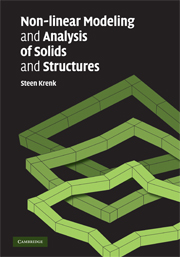Book contents
7 - Elasto-plastic solids
Published online by Cambridge University Press: 05 June 2012
Summary
A central feature of the mechanical behavior of solids and structures is the constitutive relation connecting stresses and strains. This chapter presents the basic theory of elastic and plastic solids, including the techniques needed to implement the models in the numerical framework described in previous chapters. The theoretical basis for the material models described here has developed over the last 50 years, from the early work of Ziegler (1963), over potentials with internal variables (Rice, 1971; Hill and Rice, 1973), to a fully developed theory including conjugate variables and potentials (Halphen and Son, 1975; Germain et al., 1983). A full account of this development is outside the present scope, and the chapter is limited to elastic and elasto-plastic solids. The presentation is deliberately simplified to purely mechanical effects, leaving out e.g. thermal effects, but retaining the general structure of the formulation.
First the notion of reversible elastic deformation is introduced in Section 7.1 in connection with an internal energy potential, and the concept of conjugate variables and potentials is described. The role of stress and strain invariants and some of their properties is described and used in the formulation of isotropic elasticity. The general theory of rate-independent elasto-plasticity with internal variables is then developed in Section 7.2. The key ingredients are the internal energy potential, expressing the recoverable energy in terms of elastic strains and the primary internal variables, and a yield potential, describing the limit of the region of reversible behavior.
Information
- Type
- Chapter
- Information
- Non-linear Modeling and Analysis of Solids and Structures , pp. 189 - 255Publisher: Cambridge University PressPrint publication year: 2009
